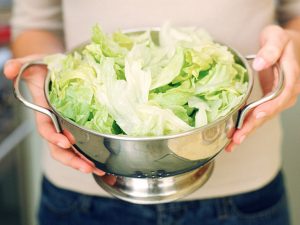My latest column for Texas A&M’s Center for Food Safety:
 There was this one time, about 32 years ago, I was sitting in the kitchen with the mother of my university girlfriend.
There was this one time, about 32 years ago, I was sitting in the kitchen with the mother of my university girlfriend.
She was peeling potatoes for boiling and mashing, and I smugly asked, why are you wasting so much potato?
“Because I don’t have all bloody day and if you’re so concerned, get off your bloody ass and bloody-well help.”
I’ve cooked ever since.
But what the mom and I didn’t know was that those potato skins could be contaminated with nasties like E. coli O157.
Potatoes, carrots, leeks, they’re grown in soil, and poop has various ways of getting into soil, so peeling potatoes should be like handling raw meat – you never bloody-well know what is contaminated and what isn’t.
Be the bug, follow the bug.
The folks at the U.K. Food Standards Agency, whose idea of science-based verification is to cook meat until it is piping hot, have apparently decided that E. coli O157:H7 – the dangerous kind – found on or in leeks, is the consumers’ responsibility.
Almost two months after revealing 250 people were sickened and one died with E. coli O157:H7 phage-type 8 over the previous eight months in 2011, linked to people handling loose raw leeks and potatoes in their homes, FSA decided to launch a campaign reminding people to wash raw vegetables to help minimize the risk of food poisoning.
 No information on how those 250 became sick and no information on farming and packing practices that may have led to such a massive contamination that so many people got sick, no information on anything: just advice to wash things thoroughly so that contamination can be spread throughout the kitchen.
No information on how those 250 became sick and no information on farming and packing practices that may have led to such a massive contamination that so many people got sick, no information on anything: just advice to wash things thoroughly so that contamination can be spread throughout the kitchen.
This outbreak combines two of the central themes of conflict and public trust in all things food: when to go public, and blaming consumers.
Often during an outbreak of foodborne illness there are health officials who have data indicating that there is a risk, prior to the public (although social media is changing that equation).
During the lag period between the first public health signal and some release of public information, there are decision-makers who are weighing evidence with the impacts of going public. Multiple agencies and analysts have lamented that there is not a common playbook or decision tree for how public health agencies determine what information to release and when. Regularly health authorities suggest that how and when public information is released is evaluated on a case-by-case basis without sharing the steps and criteria used to make decisions.
On June 2, 2008, the U.S. Centers for Disease Control and Prevention (CDC) announced that it was investigating an ongoing multistate outbreak of human Salmonella serotype Saintpaul infections. CDC identified the consumption of raw tomatoes as the likely source of the illnesses in at least two states. By the time the outbreak was officially declared over on August 28, 2008, 1,442 people had been reported infected, at least 286 people had been hospitalized, and the infection may have contributed to two deaths. Despite the early identification of tomatoes as a potential pathogen source, jalapeño peppers were subsequently identified as the major source, with some implication of serrano peppers as well.
Was the public advisory to avoid raw tomatoes issued too early in the outbreak investigation, despite its intent as a control measure? Some, including the Florida Tomato Committee may believe so, considering the outcome of the investigation and the substantial impact on the agriculture sector. The estimated economic cost to the tomato industry was more than $100 million in Florida and close to $14 million in Georgia.
In a 1999 news article about a Listeria monocytogenes outbreak, CDC foodborne illness epidemiologist Paul Mead summed up the conundrum that health officials face when reviewing preliminary data during an outbreak investigation: “Food safety recalls are always either too early or too late. If you’re right, it’s always too late. If you’re wrong, it’s always too early.” Go public too early, and make a mistake, and a corporation or industry’s reputation could unduly suffer. Go public too late, and individuals and businesses may be denied critical information they could use to protect public health.
This balancing act was most recently on display in New Zealand, following 170 confirmed cases of Yersinia pseudotuberculosis and a further 59 suspected but not confirmed cases of infection, apparently linked to lettuce.
By early Oct. 2014, enough people were sick that Food Safety Minister Jo Goodhew was compelled to finger Pams Fresh Mesclun Salad Lettuce and Pams Fresh Express Lettuce, while stressing the list was not initially released because it showed no definitive cause for the illness.
This is a disturbing trend, in that people are demanding microbiological proof when none exists – epidemiology remains a powerful and preventative public health tool.
Canterbury medical officer of health Dr Alistair Humphrey said a draft report from Environmental Science and Research (ESR) made available the previous week identified lettuce and carrots from a particular supermarket chain as the source.
“Everybody involved in this work, including MPI, ESR, all the public health units and the Ministry of Health, have seen the results of the ESR study, which is quite clear. It is unequivocal and it does name the types of food that have led to this problem and it also names one particular product,” Humphrey told Radio New Zealand.
He claimed MPI asked public health officials to keep the name of the supermarket and the products involved a secret, but he decided to name the vegetables to protect the public.
“[MPI] felt they should work with the industry rather than naming the foods but, of course, that leaves the New Zealand public slightly at risk, in my view.”
Bureaucrats are terrified of discussions of risk.
Within days of the public announcement, dozens of N.Z. Herald readers affected by the illness sent in messages describing what they went through, with many saying they were left bedridden, drowsy and debilitated.
But then the backpedaling started, portraying Living Farms, the producers of Pam’s greens, as victims of a zealous media, and by Nov., epidemiology was dumped in favor of “no Yersinia pseudotuberculosis was detected in any samples.”
Yet internal e-mails under the Official Information Act show the Ministry for Primary Industries (MPI) was mindful of balancing the risk of further illness against the risk of panicking the public and a loss of trust in the food supply chain.
An email from MPI, dated 1 October, said it considered “there will be greater ongoing positive effect and influence, with lesser risk of negative results, by managing the food safety hazard at the most likely source, ie: with industry.”
 MPI had been visiting farms and retailers to try and pinpoint the source of the bug.
MPI had been visiting farms and retailers to try and pinpoint the source of the bug.
The documents also showed MPI believed the best it could do was inform the public to wash all fruit and vegetables as a precaution.
But, in an email dated 1 October, MPI said it was likely that the suspected vegetables were contaminated with the bacteria internally, rather than just on the surface: “Meaning that washing of the produce by consumers will not afford protection from illness.” This information was not passed on to consumers.
I don’t envy anyone facing bloody accusations. Growers and others would be better served if there were clear, publicly available guidelines for when to go public about foodborne illness. And don’t bloody-well blame consumers unless it is warranted.
Dr. Douglas Powell is a former professor of food safety who shops, cooks and ferments from his home in Brisbane, Australia.
DISCLAIMER: The views and opinions expressed in this blog are those of the original creator and do not necessarily represent that of the Texas A&M Center for Food Safety or Texas A&M University.
 During the period January and up to the beginning of February, twice as many people fell ill with Yersinia infection as during the same period in a normal year. Of a total of 53 cases of Yersinia enterocolitica, 33 were resident in the regions of Stockholm, Västra Götaland and Halland.
During the period January and up to the beginning of February, twice as many people fell ill with Yersinia infection as during the same period in a normal year. Of a total of 53 cases of Yersinia enterocolitica, 33 were resident in the regions of Stockholm, Västra Götaland and Halland.










